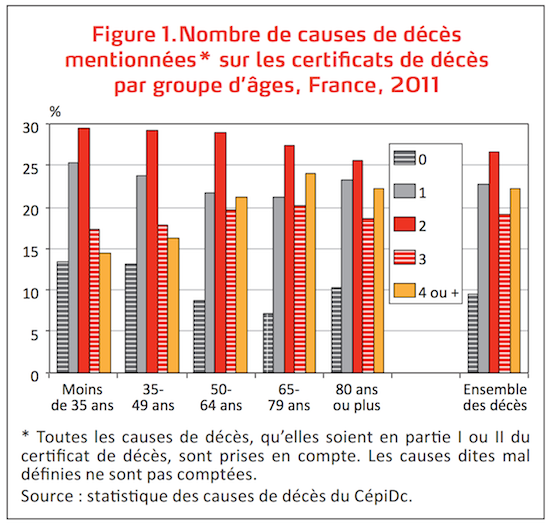You only die once, but from multiple causes. Better analyzing them is a public health issue, recalls a French study.

For James Bond, you only live twice. It is true that Her Majesty’s Secret Agent likes to risk his skin. But outside of fiction, you only die once. This is the title given by the National Institute of Demographic Studies (INED) to its last publication in its review Population & Societies. A single death does not mean a single cause. On average, 2.4 reasons are at the origin of the death of an individual.
The incidents leading to death tend to increase with age. Thus, in a quarter of people aged 65 to 79 when passing the weapon on the left, more than four causes are indicated. Among people under 35, they are only 14%.

Source : Ined, Population & Societies (2016)
Diseases that accumulate
“The fact that few causes are mentioned in the young ages of life reflects a simpler morbid process”, analyzes Aline Désesquelles, demographer at INED and author of the study. In fact, young people die mainly from external causes. With age, diseases become more complicated and co-morbidities appear. “The older we get, the more risk we have of having several pathologies and the longer they will last,” summarizes the researcher.
In the case of liver cancer, for example, chronic viral hepatitis may be involved in the process. For other diseases, such as gastric ulcers, bleeding results from the primary pathology. These are all elements that deserve to be carefully observed by experts in demography.
Aline Desesquelles, demographer at INED: ” All the pathologies that interact with the initial cause are not retained as the initial cause of death but can worsen the disease.. “
These figures were obtained thanks to an official document as essential as the birth certificate: the death certificate. Established by a doctor, it is necessary for various procedures – from closing the bank account to organizing a funeral. In demographic research, it is also very useful.
A service dedicated to certificates
According to the recommendations of the World Health Organization (WHO), the death certificate is divided into two parts. The first is to report the chain of causes that led to the death. Several can therefore be mentioned. The record was broken in 2011: 20 reasons for mortality were notified on a single document. This difference is all the more surprising given that in one in 10 cases nothing is reported. The second part makes it possible to note any other “morbid state, factor or physiological state” which seems relevant.
Aline Desesquelles : ” The second part is more ambiguous. It is a little more free in the appreciation of the doctor. This is often where we find associated chronic diseases. “
The data are then centralized at the Center for Epidemiology on Medical Causes of Death (CépiDc). This service attached to Inserm draws national statistics from them and carries out studies on mortality data. He is also authorized to transmit them to various health institutes.
Thanks to the work of the CépiDc, it is possible to observe the progression of life expectancy. We know that it has increased thanks to the decline in cancers and diseases of the circulatory system in France. The analysis of the death certificate is also of very practical interest. “It is certainly the final process of life, but it is also by relying on it that we obtain elements to improve care before death,” points out Aline Désesquelles. By defining, for example, the priority targets of public health policies.
Underestimated diseases
Death certificates are usually well filled out by doctors. But statisticians do not use their content enough, according to Aline Désesquelles. “This statistic is usually used to study the evolution of causes of death,” she explains. It is based on only one of the causes mentioned on the death certificates. But in reality, doctors mention a lot more. “
In fact, Inserm demographers only retain the initial cause of the death in their work. “It seems very important to take into account the terminal cause”, objected the demographer of INED. Infectious diseases in cancer, complications linked to diabetes are all parameters that are often forgotten.
But INED’s work sheds light on a more worrying phenomenon: the weight of certain pathologies could quite simply be underestimated because of the current analysis method.
Aline Desesquelles : ” The emphasis has been on endocrine diseases because when one takes into account associated diseases, this group of diseases is mentioned the most as associated causes. “
Respiratory diseases, blood diseases and endocrine-nutritional-metabolic diseases bear the brunt of this partial data analysis. “If we do not take them into account, we underestimate the weight of these diseases in mortality,” says Aline Désesquelles.
.















